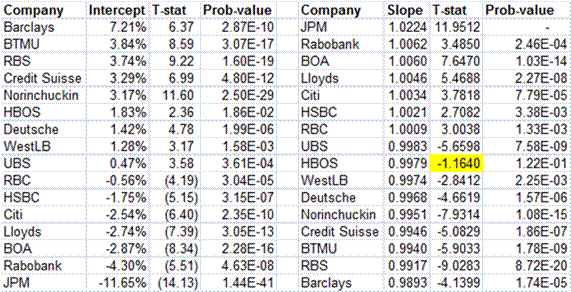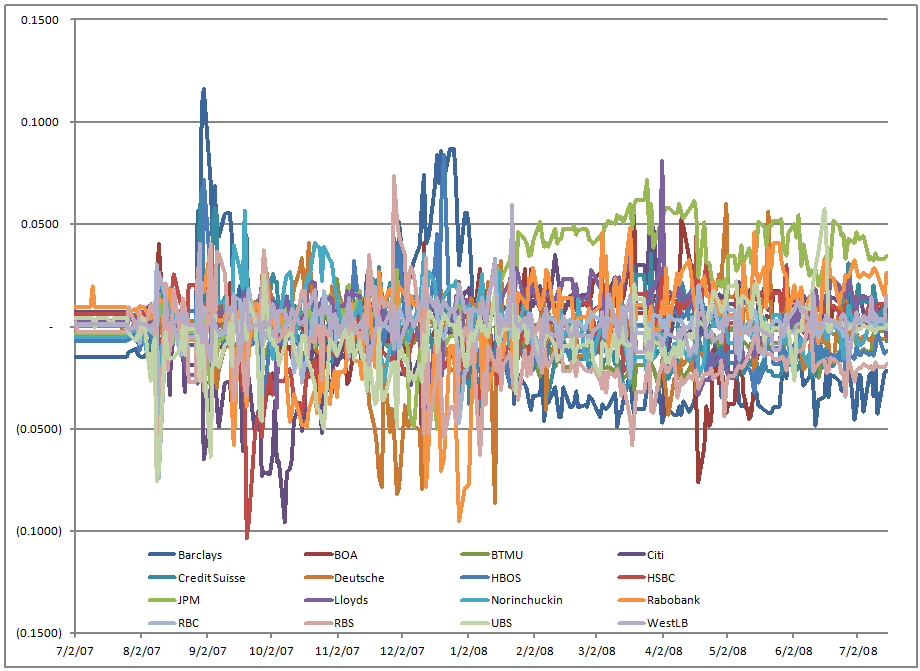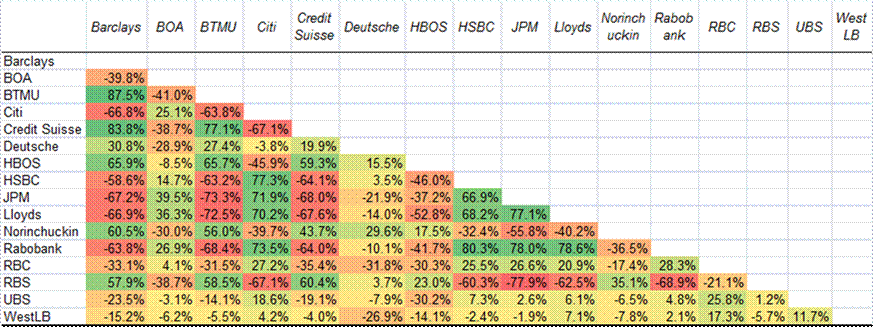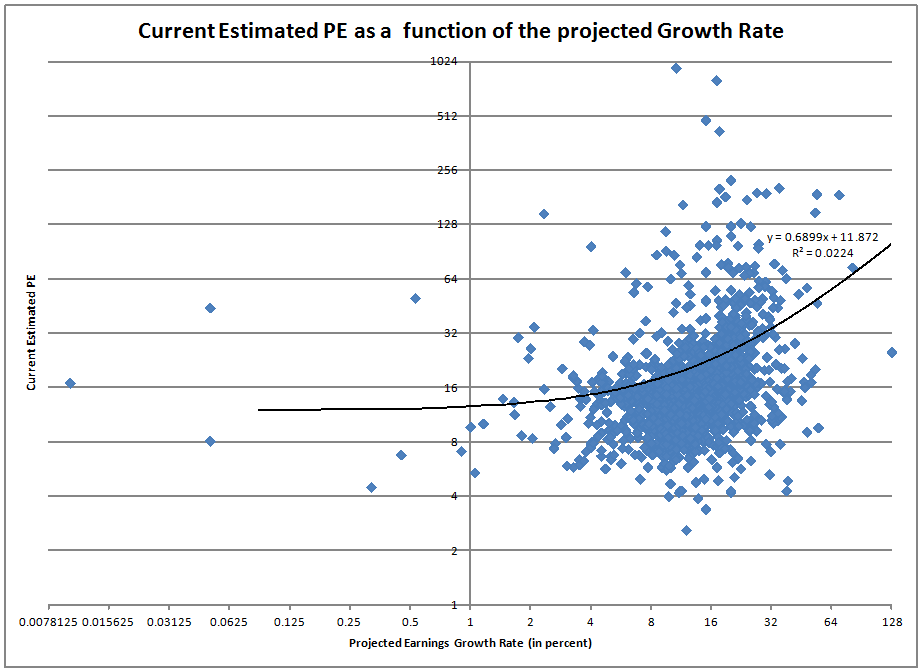Grow Embedded Value
One of my rules of thumb in equity investing is that if I buy companies trading below tangible book value,? with earnings yields over 10%, it is difficult to lose value, and the odds favor gaining value.
But there are some caveats:
- Analyze the balance sheet, highly indebted companies are not to be trusted, but that varies by industry.
- Longer dated assets, like property, plant & equipment should be discounted.
- Banks and REITs must be scrutinized carefully, because of their weak liability structures.
- Foreign companies need extra scrutiny, because the disclosures are often not as good.? This goes triple for Chinese companies.
- Make sure you are not investing in a “buggy whip” industry, particularly in the era of the internet.? How can your company be disrupted?
The idea is a simple one.? Buy companies below their tangible book value when they have good earnings, and good earnings prospects. Over a long enough period of time, the growth in tangible book value will help drive growth in the stock price.
For companies with over $100 million in market capitalization, here are the companies that fit this description:
| company | ticker | img_desc | country | exchg_desc | P / TB | P / E | Expected P/E | Mkt cap | LT Debt/ Equity |
| AerCap Holdings N.V. | AER | 0939 – Rental & Leasing | Netherlands | N – New York |
0.66 |
7.6 |
5.2 |
1524.4 |
263.6 |
| Aircastle Limited | AYR | 0939 – Rental & Leasing | United States | N – New York |
0.64 |
8.4 |
8.1 |
931.2 |
202.1 |
| American International Group, | AIG | 0715 – Insurance (Property & Casualty) | United States | N – New York |
0.55 |
2.9 |
9.8 |
56637 |
73.6 |
| Anworth Mortgage Asset Corpora | ANH | 0933 – Real Estate Operations | United States | N – New York |
0.94 |
7.8 |
7.9 |
917.8 |
3.8 |
| Assurant, Inc. | AIZ | 0709 – Insurance (Life) | United States | N – New York |
0.74 |
5.7 |
6 |
2992.7 |
19.6 |
| AXA (ADR) | AXAHY | 0709 – Insurance (Life) | France | O – Over the counter |
0.88 |
7.6 |
5.8 |
29204.3 |
21.5 |
| Axis Capital Holdings Limited | AXS | 0715 – Insurance (Property & Casualty) | Bermuda | N – New York |
0.86 |
8.3 |
8.8 |
4325.9 |
19.3 |
| AXT, Inc. | AXTI | 1033 – Semiconductors | United States | M – Nasdaq |
0.94 |
7.5 |
9.9 |
129 |
2.8 |
| Banco Bilbao Vizcaya Argentari | BBVA | 0724 – Money Center Banks | Spain | N – New York |
0.9 |
8.7 |
6 |
34554.8 |
250.4 |
| Barclays PLC (ADR) | BCS | 0727 – Regional Banks | United Kingdom | N – New York |
0.42 |
6.9 |
3.6 |
31291.9 |
44.7 |
| Callon Petroleum Company | CPE | 0609 – Oil & Gas Operations | United States | N – New York |
0.86 |
1.7 |
5.8 |
171.6 |
62.6 |
| Chimera Investment Corporation | CIM | 0703 – Consumer Financial Services | United States | N – New York |
0.73 |
4.6 |
5.3 |
2434.6 |
59.2 |
| China Gerui Adv Mtals Grp Ltd | CHOP | 0121 – Iron & Steel | China | M – Nasdaq |
0.55 |
2.3 |
1.7 |
157.4 |
0 |
| China Zenix Auto International | ZX | 0415 – Auto & Truck Parts | China | N – New York |
0.49 |
1.8 |
1.4 |
127.3 |
0 |
| Citigroup Inc. | C | 0724 – Money Center Banks | United States | N – New York |
0.53 |
7.4 |
5.8 |
77291.7 |
165.3 |
| Corning Incorporated | GLW | 1024 – Electronic Instruments & Controls | United States | N – New York |
0.95 |
8 |
8.4 |
19410 |
14.7 |
| Crexus Investment Corp | CXS | 0933 – Real Estate Operations | United States | N – New York |
0.85 |
6.6 |
9.4 |
779.2 |
0 |
| Deutsche Bank AG (USA) | DB | 0727 – Regional Banks | Germany | N – New York |
0.65 |
7.6 |
4.7 |
31543.1 |
318.7 |
| GeoEye Inc. | GEOY | 0909 – Business Services | United States | M – Nasdaq |
0.8 |
7.3 |
8.7 |
358.5 |
97.6 |
| Hardinge Inc. | HDNG | 0218 – Misc. Capital Goods | United States | M – Nasdaq |
0.74 |
8 |
7.4 |
105.1 |
4.3 |
| Homex Development Corp. (ADR) | HXM | 0215 – Construction Services | Mexico | N – New York |
0.91 |
8.6 |
5.5 |
846.4 |
85.4 |
| Ingles Markets, Incorporated | IMKTA | 0957 – Retail (Grocery) | United States | M – Nasdaq |
0.91 |
9.9 |
8.2 |
400 |
183.1 |
| Ingram Micro Inc. | IM | 1006 – Computer Hardware | United States | N – New York |
0.77 |
9.6 |
7.6 |
2591.2 |
8.7 |
| Jinpan International Limited | JST | 1024 – Electronic Instruments & Controls | China | M – Nasdaq |
0.85 |
5.3 |
4.7 |
132 |
0.8 |
| Kelly Services, Inc. | KELYA | 0909 – Business Services | United States | M – Nasdaq |
0.77 |
6.4 |
7.4 |
462.9 |
0 |
| KeyCorp | KEY | 0727 – Regional Banks | United States | N – New York |
0.83 |
8.4 |
9.5 |
7339.2 |
90.7 |
| KKR Financial Holdings LLC | KFN | 0718 – Investment Services | United States | N – New York |
0.89 |
5.1 |
4.7 |
1557.4 |
0 |
| Knightsbridge Tankers Limited | VLCCF | 1118 – Water Transportation | Bermuda | M – Nasdaq |
0.61 |
6.9 |
9.4 |
215.2 |
42 |
| KT Corporation (ADR) | KT | 0915 – Communications Services | South Korea | N – New York |
0.89 |
9 |
7 |
7041.3 |
72.6 |
| Le Gaga Holdings Ltd ADR | GAGA | 0509 – Crops | Hong Kong | M – Nasdaq |
0.89 |
8.1 |
4.1 |
200.3 |
5.3 |
| Lihua International Inc | LIWA | 0127 – Misc. Fabricated Products | China | M – Nasdaq |
0.7 |
3.1 |
2.1 |
161.3 |
0 |
| LUKOIL (ADR) | LUKOY | 0606 – Oil & Gas – Integrated | Russia | O – Over the counter |
0.68 |
4.2 |
4 |
47753.8 |
10.4 |
| Mechel OAO (ADR) | MTL | 0124 – Metal Mining | Russia | N – New York |
0.8 |
4.6 |
3.5 |
3322.6 |
139.6 |
| Metlife Inc | MET | 0709 – Insurance (Life) | United States | N – New York |
0.69 |
5.7 |
5.4 |
32402.5 |
45.3 |
| Mizuho Financial Group Inc. (A | MFG | 0727 – Regional Banks | Japan | N – New York |
0.9 |
3.5 |
8.5 |
40165.5 |
236.3 |
| Navios Maritime Holdings Inc. | NM | 1118 – Water Transportation | Greece | N – New York |
0.53 |
4.6 |
7.6 |
350.3 |
131.3 |
| Newfield Exploration Co. | NFX | 0609 – Oil & Gas Operations | United States | N – New York |
0.98 |
5.9 |
8.8 |
3943.1 |
72.2 |
| Olympic Steel, Inc. | ZEUS | 0127 – Misc. Fabricated Products | United States | M – Nasdaq |
0.86 |
8.8 |
6.4 |
181.8 |
95.4 |
| Orbotech Ltd. | ORBK | 1033 – Semiconductors | Israel | M – Nasdaq |
0.78 |
6.3 |
9.7 |
329.7 |
13.1 |
| Patterson-UTI Energy, Inc. | PTEN | 0612 – Oil Well Services & Equipment | United States | M – Nasdaq |
0.93 |
6.6 |
8.3 |
2276.5 |
18.7 |
| Petroleo Brasileiro SA (ADR) | PBR | 0606 – Oil & Gas – Integrated | Brazil | N – New York |
0.9 |
6.8 |
6.3 |
126006.1 |
43.5 |
| Phoenix Companies, Inc., The | PNX | 0709 – Insurance (Life) | United States | N – New York |
0.21 |
3.6 |
3.7 |
203.5 |
45 |
| Popular, Inc. | BPOP | 0727 – Regional Banks | Puerto Rico | M – Nasdaq |
0.52 |
8.9 |
6.1 |
1664 |
47.1 |
| Protective Life Corp. | PL | 0709 – Insurance (Life) | United States | N – New York |
0.7 |
7.2 |
8 |
2557 |
53 |
| Reinsurance Group of America I | RGA | 0706 – Insurance (Accident & Health) | United States | N – New York |
0.68 |
7.8 |
7.2 |
4059.3 |
34.9 |
| Republic Bancorp, Inc. KY | RBCAA | 0727 – Regional Banks | United States | M – Nasdaq |
0.94 |
4.7 |
8.7 |
489.6 |
7.7 |
| REX American Resources Corp | REX | 0103 – Chemical Manufacturing | United States | N – New York |
0.65 |
7.8 |
6.8 |
163.9 |
41 |
| Royal Caribbean Cruises Ltd. | RCL | 1118 – Water Transportation | United States | N – New York |
0.71 |
9.7 |
9.5 |
5542.1 |
91.9 |
| Societe Generale SA (ADR) | SCGLY | 0724 – Money Center Banks | France | O – Over the counter |
0.29 |
5.8 |
3.8 |
16945.2 |
20.7 |
| StanCorp Financial Group, Inc. | SFG | 0706 – Insurance (Accident & Health) | United States | N – New York |
0.84 |
2.5 |
8.7 |
1676.1 |
14.8 |
| StealthGas Inc. | GASS | 1118 – Water Transportation | Greece | M – Nasdaq |
0.38 |
8.5 |
5 |
122.1 |
98.5 |
| Symetra Financial Corporation | SYA | 0709 – Insurance (Life) | United States | N – New York |
0.47 |
7.8 |
8.5 |
1494.6 |
0 |
| Tech Data Corp | TECD | 1006 – Computer Hardware | United States | M – Nasdaq |
0.96 |
9.8 |
8 |
1918.9 |
2.9 |
| Ternium S.A. (ADR) | TX | 0121 – Iron & Steel | Luxembourg | N – New York |
0.81 |
8.3 |
5.8 |
3993.4 |
26.2 |
| Thompson Creek Metals Company, | TC | 0124 – Metal Mining | United States | N – New York |
0.33 |
3.5 |
5.7 |
563.9 |
20.8 |
| Transportadora de Gas del Sur | TGS | 0609 – Oil & Gas Operations | Argentina | N – New York |
0.43 |
5.6 |
7.5 |
191.7 |
80.6 |
| TravelCenters of America LLC | TA | 0963 – Retail (Specialty Non-Apparel) | United States | A – American |
0.51 |
4 |
3.7 |
145 |
31.9 |
| Triple-S Management Corp. | GTS | 0806 – Healthcare Facilities | Puerto Rico | N – New York |
0.76 |
9.4 |
8.6 |
510.6 |
18.2 |
| Unit Corporation | UNT | 0612 – Oil Well Services & Equipment | United States | N – New York |
0.94 |
8.7 |
9 |
1819.7 |
15.8 |
| Valero Energy Corporation | VLO | 0609 – Oil & Gas Operations | United States | N – New York |
0.86 |
9.1 |
5.6 |
13578.5 |
40.5 |
| Vishay Intertechnology | VSH | 1033 – Semiconductors | United States | N – New York |
0.97 |
7.7 |
7.1 |
1433.8 |
23.4 |
| Woori Finance Holdings Co., Lt | WF | 0727 – Regional Banks | South Korea | N – New York |
0.57 |
4.5 |
4.8 |
8482.1 |
0 |
| Xinyuan Real Estate Co., Ltd. | XIN | 0215 – Construction Services | China | N – New York |
0.33 |
2 |
2.1 |
215.1 |
8.8 |
| Yongye International Inc | YONG | 0103 – Chemical Manufacturing | China | M – Nasdaq |
0.55 |
1.9 |
1.3 |
163.7 |
2.8 |
| ZHONGPIN INC. | HOGS | 0515 – Food Processing | China | M – Nasdaq |
0.89 |
6.6 |
5.5 |
371.9 |
18.1 |
| Zuoan Fashion Ltd (ADR) | ZA | 0403 – Apparel/Accessories | China | N – New York |
0.6 |
2.4 |
1.8 |
102.1 |
0 |
Full disclosure: long AIZ, PBR, RGA, SFG, VLO
PS — be wary of Chinese companies, I mean it…? Also, use the Ctrl-Minus key to view this in entire.










